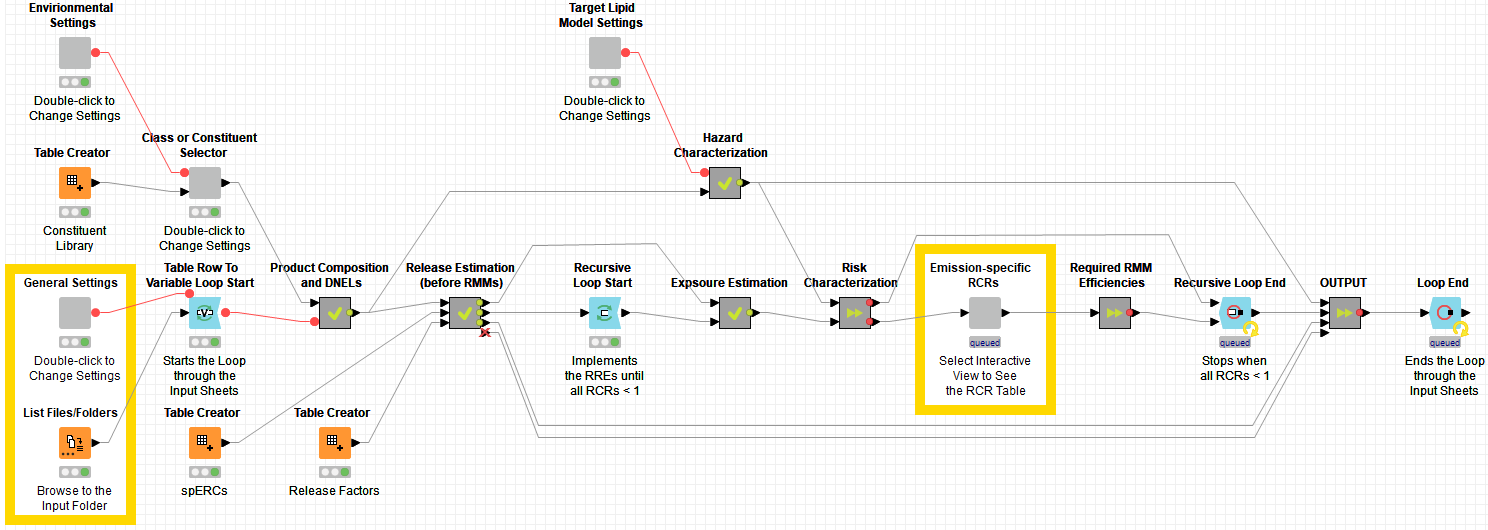PETRORISK
PetroRisk has been programmed as a workflow in the Konstanz Information Miner (KNIME), which is an open source data analytics, reporting and integration platform based on Eclipse and written in Java. An intuitive drag and drop style graphical user interface allows visual assembly, execution and analysis of complex workflows.

Figure 1. The KNIME PetroRisk 8.01 workflow
For the water, soil, sediment and STP compartments, a risk characterization ratio (RCR) is calculated for each representative hydrocarbon:
RCR = PEC/PNEC
wherein the hydrocarbon-specific Predicted No-Effect Concentration (PNEC) is derived with the Target Lipid Model (TLM). The RCRs are subsequently summed to reflect the ecological risk of the entire substance in each environmental compartment.
Human exposures are calculated for each representative hydrocarbon by multiplying the PECs in air, drinking water and foodstuff with the related daily human intake rates. Compared to the Guidance approach, PetroRisk uses a refined ‘Man via Environment’ model, resulting in more realistic human exposure predictions. The hydrocarbon-specific human exposure via inhalation and ingestion are summed to reflect the respiratory and dietary exposure to the entire substance. Both human exposures are subsequently divided by the related Derived No Effect Levels (DNEL) to obtain substance-specific respiratory and dietary RCRs. The applied substance DNELs are usually derived from available mammalian toxicity data on the substance or a marker compound (e.g., benzene).
RCR values above 1 indicate that the assessment does not support safe use, and may require further refinement or consideration of additional RMMs or process controls. In such case, the user should consider refining the applied operational conditions (OC) that describe the Generic Exposure Scenario (GES) of the use. PetroRisk can automatically calculate and mathematically implement a set of Risk Management Measures (RMMs) that achieves ‘safe’ air and wastewater emission levels (i.e., resulting in RCRs ≤ 1).
The tool can successfully handle large batches of input files, if these are set up appropriately and provided in a single folder. The results are captured both as a single data table at the end of the PetroRisk workflow and as individual, substance-specific Excel-based output files.
The PetroRisk manual can be downloaded here.
The latest version of the KNIME Analytics Platform installer can be downloaded here.
A user-friendly Excel-VBA based ‘scaling’ tool is also provided, to facilitate the extrapolation of a PetroRisk-derived GES to site-specific use conditions. The most recent version of the PetroRisk Scaling Tool can be downloaded here.
Given that KNIME, the PetroRisk workflow and scaling tool are regularly updated, we recommend downloading the latest version(s) before each use.
If you have any questions, concerns, suggestions or encounter issues with PetroRisk or its scaling tool, please contact Concawe.
*Disclaimer of warranties and liabilities
This disclaimer is issued in regard to the tool referred to as PetroRisk. The tool PetroRisk is being made available without charge or restriction except as stated in the next sentence. No recipient of PetroRisk shall: (i) copyright or patent it in any form; (ii) redistribute it to others without Concawe’s prior written authorization; (iii) make a monetary charge for it.
To the extent not contrary to law, Concawe, its members, subsidiaries and affiliates shall not accept any liability for the PetroRisk tool or its use. Concawe its members, subsidiaries and affiliates shall not, in connection with PetroRisk, be liable for, including without limitation, the following : (i) damage to, or loss of, property; (ii) infringement of intellectual property rights; (iii) loss of, reduction in or interruption of business; (iv) loss of, or failure to achieve, revenue or profit; (v) increased costs of operation; (vi) loss of materials or information; (vii) computer failure or malfunction; (viii) special, direct, indirect, incidental, punitive or consequential damages; or (ix) any use of the tool. The preceding disclaimer shall apply whether or not liability results, or is claimed to result, from negligence or other circumstances.
Concawe does not represent or warrant that PetroRisk is free from defect or deficiency. Recipient shall be solely responsible for correction of defects or deficiencies, if any. There are no warranties, express or implied, including, without limitation, warranties of merchantability or suitability for a purpose.
Each recipient shall indemnify and defend Concawe against claims, liabilities, actions, costs and expenses which may result from recipient’s violation of the provisions of this disclaimer.
Given that PetroRisk files are regularly updated please download the latest version of PetroRisk each time you use the tool.